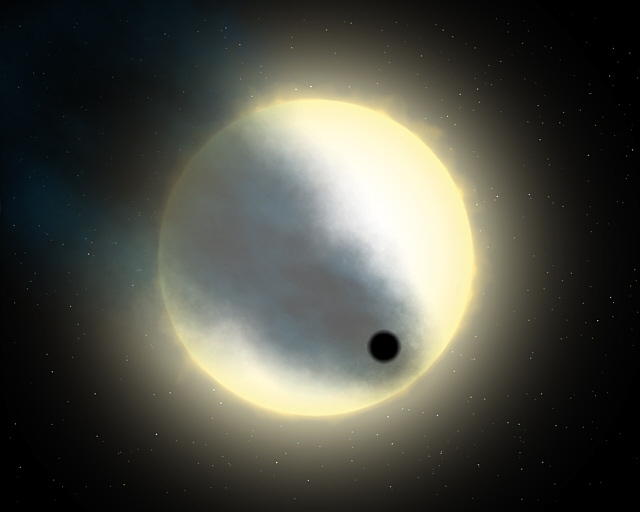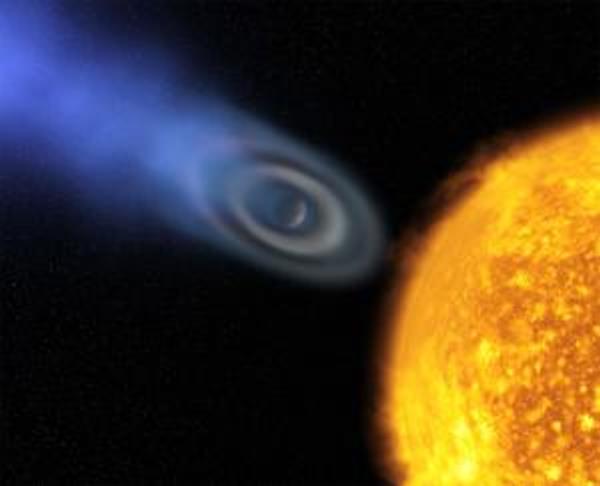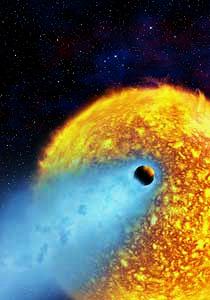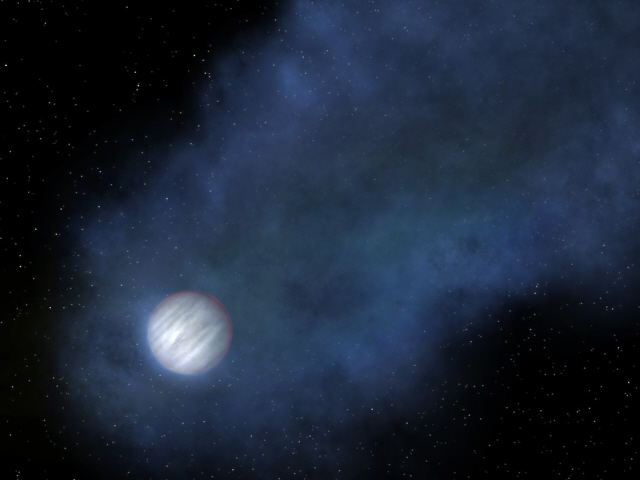|
Extra Solar Planets New Planets Discovered |
||
|
Planet Osiris, Pegasus Constellation HD 209458 b Transiting
Osiris
From the vantage point of the
Earth, the planet of HD 209458 moves across the
face of its star once every
few days. Such transits allow astronomers to
probe the planet's atmosphere.
A surprising discovery was that the planet
heated to such high temperatures
by it star, that its atmosphere is slowly
escaping into space, forming
a long tail that dims the star as it trails
behind the planet. - Source
HD 209458 b HD 209458 b is an extrasolar planet that orbits the Sun-like star HD 209458 in the constellation Pegasus, some 150 light-years from Earth's solar system. HD 209458 is a 7th magnitude star, visible from Earth with binoculars. The radius of the planet's orbit is 7 million kilometers, ~0.047 astronomical units, one eighth the radius of Mercury's orbit. This small radius results in a year that is 3.5 Earth days long and an estimated surface temperature of about 1000 degrees Celsius or around 1800 degrees Fahrenheit. Its mass is 220 times that of Earth's (0.69 Jupiter masses), which indicates that it is probably a gas giant. HD 209458 b was the first transiting extrasolar planet discovered, the first extrasolar planet known to have an atmosphere, the first extrasolar planet observed to have an evaporating hydrogen atmosphere, the first extrasolar planet found to have an atmosphere containing oxygen and carbon, and one of the first two extrasolar planets to be directly spectroscopically observed. It is also the first extrasolar planet found to have water vapor in its atmosphere. HD 209458 b is informally known as Osiris, though this name was not given by the astronomers credited with its discovery, nor is it accepted by the International Astronomical Union. Discovery Spectroscopic studies first revealed the presence of a planet around HD 209458 on November 5, 1999. Astronomers had made careful photometric measurements of several stars known to be orbited by planets, in the hope that they might observe a dip in brightness caused by the transit of the planet across the star's face. This would require the planet's orbit to be inclined such that it would pass between the Earth and the star, and previously no transits had been detected. Atmospheric water vapor On April 10, 2007, Travis Barman of the Lowell Observatory announced evidence that the atmosphere of HD 209458 b contained water vapor. Using a combination of previously published Hubble Space Telescope measurements and new theoretical models, Barman found strong evidence for water absorption in the planet's atmosphere. His method modeled light passing directly through the atmosphere from the planet's sun as the planet passed in front of its sun. However, this hypothesis is still being investigated for further proof. Barman drew on data and measurements taken by Heather Knutson, a student at Harvard University, from the Hubble Space Telescope, and applied new theoretical models to demonstrate the likelihood of water absorption in the atmosphere of the planet. The planet orbits its parent star every three and a half days, and each time it passes in front of its parent star, the atmospheric contents can be analysed by examining how the atmosphere absorbs light passing from the star directly through the atmosphere in the direction of Earth. According to a summary of the research, atmospheric water absorption in such an exoplanet renders it larger in appearance across one part of the infrared spectrum, compared to wavelengths in the visible spectrum. Barman took Knutson's Hubble data on HD209458 b, applied to his theoretical model and subsequently identified water absorption in the planet's atmosphere. Dying
planet
being consumed by its sun - Thursday, 13
March 2003
|
||
|
.
This artist's impression shows
an extended ellipsoidal envelope - the shape of
a rugby-ball – of oxygen
and carbon discovered around the well-known
extrasolar planet HD 209458b.
The atoms of carbon and oxygen are swept up from
the lower atmosphere with
the flow of escaping atmospheric atomic hydrogen
- like dust in a supersonic
whirlwind – in a process called atmospheric
‘blow off'. Credit: ESA &
Alfred Vidal-Madjar (Institut d'Astrophysique de
Paris, CNRS, France) -
Source
Related Links:
Credit: ESA, Alfred Vidal-Madjar (Institut d'Astrophysique de Paris, CNRS, France) and NASA |
||
|
.
The planet of HD 209458, unofficially
named Osiris, is so close to its star that its
atmosphere is literally
boiling away into space. Here we see the dim
blue glow of energized hydrogen
gas escaping the planet's atmosphere, extending
into a comet-like tail.
- Source
|
||
| FAIR USE NOTICE: This page contains copyrighted material the use of which has not been specifically authorized by the copyright owner. Pegasus Research Consortium distributes this material without profit to those who have expressed a prior interest in receiving the included information for research and educational purposes. We believe this constitutes a fair use of any such copyrighted material as provided for in 17 U.S.C § 107. If you wish to use copyrighted material from this site for purposes of your own that go beyond fair use, you must obtain permission from the copyright owner. | ||
|
|




